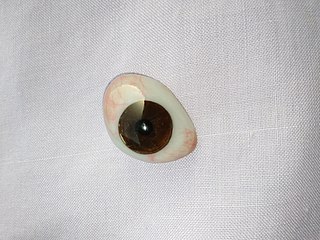Related Research Articles

A cataract is a cloudy area in the lens of the eye that leads to a decrease in vision of the eye. Cataracts often develop slowly and can affect one or both eyes. Symptoms may include faded colours, blurry or double vision, halos around light, trouble with bright lights, and difficulty seeing at night. This may result in trouble driving, reading, or recognizing faces. Poor vision caused by cataracts may also result in an increased risk of falling and depression. Cataracts cause 51% of all cases of blindness and 33% of visual impairment worldwide.

Vitrectomy is a surgery to remove some or all of the vitreous humor from the eye.

Far-sightedness, also known as long-sightedness, hypermetropia, and hyperopia, is a condition of the eye where distant objects are seen clearly but near objects appear blurred. This blur is due to incoming light being focused behind, instead of on, the retina due to insufficient accommodation by the lens. Minor hypermetropia in young patients is usually corrected by their accommodation, without any defects in vision. But, due to this accommodative effort for distant vision, people may complain of eye strain during prolonged reading. If the hypermetropia is high, there will be defective vision for both distance and near. People may also experience accommodative dysfunction, binocular dysfunction, amblyopia, and strabismus. Newborns are almost invariably hypermetropic, but it gradually decreases as the newborn gets older.

Eye surgery, also known as ophthalmic surgery or ocular surgery, is surgery performed on the eye or its adnexa. Eye surgery is part of ophthalmology and is performed by an ophthalmologist or eye surgeon. The eye is a fragile organ, and requires due care before, during, and after a surgical procedure to minimize or prevent further damage. An eye surgeon is responsible for selecting the appropriate surgical procedure for the patient, and for taking the necessary safety precautions. Mentions of eye surgery can be found in several ancient texts dating back as early as 1800 BC, with cataract treatment starting in the fifth century BC. It continues to be a widely practiced class of surgery, with various techniques having been developed for treating eye problems.

Phacoemulsification is a cataract surgery method in which the internal lens of the eye which has developed a cataract is emulsified with the tip of an ultrasonic handpiece and aspirated from the eye. Aspirated fluids are replaced with irrigation of balanced salt solution to maintain the volume of the anterior chamber during the procedure. This procedure minimises the incision size and reduces the recovery time and risk of surgery induced astigmatism.

An Intraocular lens (IOL) is a lens implanted in the eye usually as part of a treatment for cataracts or for correcting other vision problems such as short sightedness and long sightedness; a form of refractive surgery. If the natural lens is left in the eye, the IOL is known as phakic, otherwise it is a pseudophakic lens. Both kinds of IOLs are designed to provide the same light-focusing function as the natural crystalline lens. This can be an alternative to LASIK, but LASIK is not an alternative to an IOL for treatment of cataracts.

Retinal detachment is a disorder of the eye in which the retina peels away from its underlying layer of support tissue. Initial detachment may be localized, but without rapid treatment the entire retina may detach, leading to vision loss and blindness. It is a surgical emergency.

Aniridia is the absence of the iris, a muscular structure that opens and closes the pupil to allow light into the eye. It is also responsible for eye color. Without it, the central eye appears all black. It can be congenital, in which both eyes are usually involved, or caused by a penetrant injury. Isolated aniridia is a congenital disorder that is not limited to a defect in iris development, but is a panocular condition with macular and optic nerve hypoplasia, cataract, and corneal changes. Vision may be severely compromised and the disorder is frequently associated with some ocular complications: nystagmus, amblyopia, buphthalmos, and cataract. Aniridia in some individuals occurs as part of a syndrome, such as WAGR syndrome, or Gillespie syndrome.

A phakic intraocular lens (PIOL) is an intraocular lens that is implanted surgically into the eye to correct refractive errors without removing the natural lens. Intraocular lenses that are implanted into eyes after the eye's natural lens has been removed during cataract surgery are known as pseudophakic.

Cataract surgery, also called lens replacement surgery, is the removal of the natural lens of the eye that has developed a cataract, an opaque or cloudy area. The eye's natural lens is usually replaced with an artificial intraocular lens (IOL) implant.
Aphakia is the absence of the lens of the eye, due to surgical removal, such as in cataract surgery, a perforating wound or ulcer, or congenital anomaly. It causes a loss of ability to maintain focus (accommodation), high degree of farsightedness (hyperopia), and a deep anterior chamber. Complications include detachment of the vitreous or retina, and glaucoma.
Polycoria is a pathological condition of the eye characterized by more than one pupillary opening in the iris. It may be congenital or result from a disease affecting the iris. It results in decreased function of the iris and pupil, affecting the physical eye and visualization.

An ocular prosthesis, artificial eye or glass eye is a type of craniofacial prosthesis that replaces an absent natural eye following an enucleation, evisceration, or orbital exenteration. The prosthesis fits over an orbital implant and under the eyelids. Though often referred to as a glass eye, the ocular prosthesis roughly takes the shape of a convex shell and is made of medical grade plastic acrylic. A few ocular prostheses today are made of cryolite glass. A variant of the ocular prosthesis is a very thin hard shell known as a scleral shell which can be worn over a damaged or eviscerated eye. Makers of ocular prosthetics are known as ocularists. An ocular prosthesis does not provide vision; this would be a visual prosthesis. Someone with an ocular prosthesis is altogether blind on the affected side and has monocular vision.

Corneal tattooing is the practice of tattooing the cornea of the human eye. Reasons for this practice include improvement of cosmetic appearance and the improvement of sight. Many different methods and procedures exist today, and there are varying opinions concerning the safety or success of this practice.

Boston keratoprosthesis is a collar button design keratoprosthesis or artificial cornea. It is composed of a front plate with a stem, which houses the optical portion of the device, a back plate and a titanium locking c-ring. It is available in type I and type II formats. The type I design is used much more frequently than the type II which is reserved for severe end stage dry eye conditions and is similar to the type I except it has a 2 mm anterior nub designed to penetrate through a tarsorrhaphy. The type I format will be discussed here as it is more commonly used.
Howard V. Gimbel FRCSC, AOE, FACS, CABES, is a Canadian ophthalmologist, university professor, senior editor, and amateur musician. He is better known for his invention, along with Thomas Neuhann, of the continuous curvilinear capsulorhexis (CCC), a technique employed in modern cataract surgery.
Iris-fixated intraocular lens is an intraocular lens that is implanted surgically into the eye and attached to the iris. Originally developed for aphakia, phakic versions have also been produced to correct myopia (nearsightedness), hyperopia (farsightedness), and astigmatism. They are suited for correction of eyes where corneal refractive surgery is not applicable.

In ophthalmology, glued intraocular lens or glued IOL is a surgical technique for implantation, with the use of biological glue, of a posterior chamber IOL in eyes with deficient or absent posterior capsules. A quick-acting surgical fibrin sealant derived from human blood plasma, with both hemostatic and adhesive properties, is used.

Peter Szurman is a German ophthalmologist, scientist, and professor of ophthalmology in Sulzbach/Saar.
Manual small incision cataract surgery (MSICS) is an evolution of extracapsular cataract extraction (ECCE); the lens is removed from the eye through a self-sealing scleral tunnel wound. A well-constructed scleral tunnel is held closed by internal pressure, is watertight, and does not require suturing. The wound is relatively smaller than that in ECCE but is still markedly larger than a phacoemulsification wound. Comparative trials of MSICS against phaco in dense cataracts have found no statistically significant difference in outcomes but MSICS had shorter operating times and significantly lower costs. MSICS has become the method of choice in the developing world because it provides high-quality outcomes with less surgically induced astigmatism than ECCE, no suture-related problems, quick rehabilitation, and fewer post-operative visits. MSICS is easy and fast to learn for the surgeon, cost effective, simple, and applicable to almost all types of cataract.
References
- ↑ Shahreef, Farah J. (April 2016). "Engineering a Light-Attenuating Artificial Iris". iovs.arvojournals.org. Retrieved 2023-10-17.
- 1 2 3 4 Mayer, Christian; Tandogan, Tamer; Hoffmann, Andrea E.; Khoramnia, Ramin (2017-06-01). "Artificial iris implantation in various iris defects and lens conditions". Journal of Cataract & Refractive Surgery. 43 (6): 724–731. doi: 10.1016/j.jcrs.2017.06.003 . ISSN 0886-3350.
- 1 2 Charters, Lynda (2022-04-30). "Cosmetic iris implants pose high risk of vision loss". MJH Life Sciences. Retrieved 2024-06-29.
- ↑ Galehouse, Maggie (2019-06-03). "Building a durable, flexible iris". TMC News. Retrieved 2023-10-24.
- 1 2 3 4 Rickmann, Annekatrin; Szurman, Peter; Januschowski, Kai; Waizel, Maria; Spitzer, Martin S.; Boden, Karl T.; Szurman, Gesine B. (2016-07-01). "Long-term results after artificial iris implantation in patients with aniridia". Graefe's Archive for Clinical and Experimental Ophthalmology. 254 (7): 1419–1424. doi:10.1007/s00417-016-3292-3. ISSN 1435-702X.
- 1 2 3 "The Artificial Iris: Technically Challenging and Unusually Rewarding". American Academy of Ophthalmology. 2022-05-01. Retrieved 2023-10-24.
- 1 2 3 4 Szurman, P.; Jaissle, G. (2011-08-01). "Künstliche Iris". Der Ophthalmologe (in German). 108 (8): 720–727. doi:10.1007/s00347-011-2367-0. ISSN 1433-0423.
- ↑ Sugiura, Takeshi; Kaji, Yuichi; Tanaka, Yoshikazu (2019-06-01). "Ciliary sulcus suture fixation of intraocular lens using an auxiliary device". Journal of Cataract & Refractive Surgery. 45 (6): 711–718. doi: 10.1016/j.jcrs.2019.01.021 . ISSN 0886-3350.
- 1 2 Pfeifer, Vladimir; Marzidovšek, Miha; Lužnik, Zala (2022), Alió, Jorge L.; Dick, H. Burkhard; Osher, Robert H. (eds.), "Artificial Iris Implantation: Overview of Surgical Techniques", Cataract Surgery : Advanced Techniques for Complex and Complicated Cases, Essentials in Ophthalmology, Cham: Springer International Publishing, pp. 321–338, doi:10.1007/978-3-030-94530-5_29, ISBN 978-3-030-94530-5 , retrieved 2023-10-24
- ↑ Mayer, Christian S.; Laubichler, Andrea E.; Khoramnia, Ramin; Tandogan, Tamer; Prahs, Philipp; Zapp, Daniel; Reznicek, Lukas (2018-09-23). "Challenges and Complication Management in Novel Artificial Iris Implantation". Journal of Ophthalmology. 2018: e3262068. doi: 10.1155/2018/3262068 . ISSN 2090-004X.
- ↑ Ophthalmologists & Retina Specialists of Vitreous Retina Macula Consultants of New York. "Silicone Oil". Vitreous Retina Macula Consultants of New York. Retrieved 2023-11-07.
- ↑ Heimann, K; Konen, W (1992-01-01). "Artificial iris diaphragm and silicone oil surgery". Retina (Philadelphia, Pa.). 12 (3 Suppl): S90–4. doi:10.1097/00006982-199212031-00019. ISSN 1539-2864. PMID 1455092.
- 1 2 Pfeifer, Vladimir; Marzidovšek, Miha; Lužnik, Zala (2022), Alió, Jorge L.; Dick, H. Burkhard; Osher, Robert H. (eds.), "Artificial Iris Implantation: Overview of Surgical Techniques", Cataract Surgery : Advanced Techniques for Complex and Complicated Cases, Essentials in Ophthalmology, Cham: Springer International Publishing, pp. 321–338, doi:10.1007/978-3-030-94530-5_29, ISBN 978-3-030-94530-5 , retrieved 2023-11-09
- 1 2 3 4 13 Iris Prosthesis Implantation (2019 ed.). Thieme Verlag. 2019. doi:10.1055/b-0039-172073?update=true&ersessiontoken=mzkx2fqerwp6kgo6cxuouj3nxxemsx2fj3xxx2fj-18x2dpg7ppo5x2bkxojrrz45h82sgx3dx3dtsffokvradvwuoth7n4o5gx3dx3d-d4x2frgr0sqp5kuk8uh7xqkwx3dx3d-6gokcciajjgorkjfx2vu8gx3dx3d#. ISBN 978-1-68420-097-9.
- ↑ "FDA clears first artificial iris by HumanOptics". American Academy of Ophthalmology. 2018-06-04. Retrieved 2023-11-09.